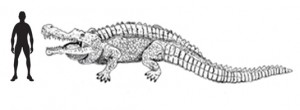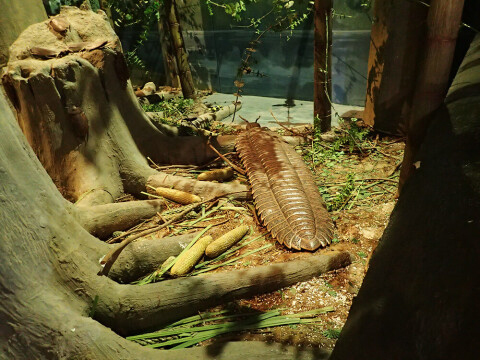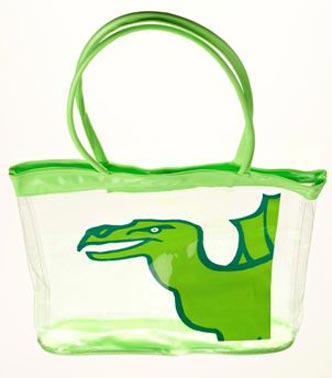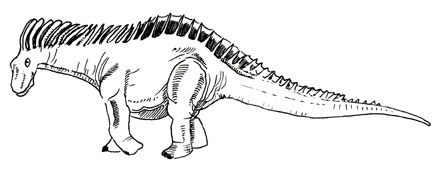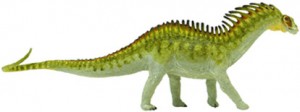The Mother of All Sauropods – Ancestor of the Long-Necked Dinosaurs
New Basal Sauropod Discovered in South America
Fossils of a basal sauropod are helping palaeontologists to revise the Dinosauria cladogram.
The Order Dinosauria is divided into two fundamental groups the Saurischia (lizard-hipped dinosaurs) and the Ornithischia (bird-hipped dinosaurs). This classification was established in the 19th century and, although the terminology is a little confusing the basic cladogram of dinosaur relationships has remained largely unchanged.
Dinosauria Classification
Dinosaurs are classified into different groups or families according to anatomical features that their skeletons reveal. If two dinosaur fossils are shown to have very similar anatomical features it is likely that they will be classified together, whereas a third dinosaur fossil which demonstrates different features will be placed further away on the dinosaur family tree. The two basic groups – Ornithischia and Saurischia are distinguished by having markedly different hip structures. This is of course, greatly simplified, there are in fact about a dozen characteristics that distinguish dinosaurs from other reptiles.
The terminology used may not have changed since the days of Owen and Huxley but our greater understanding of dinosaur taxonomy has led to many scientists suggesting a re-think when it comes to classifying dinosaurs. For example, the ornithischian dinosaurs, the bird-hipped dinosaurs are not, as the name would suggest, as closely related to birds as the Saurischia.
Dinosaur Evolution
How dinosaurs first evolved and then developed into their myriad forms has been a question that has long puzzled palaeontologists. The lack of fossil evidence has frustrated many a researcher, the rise of the dinosaurs and their evolution into such diverse forms remains a mystery. It is difficult to identify basal forms and work out the evolution of certain types of dinosaur with so little evidence preserved in the fossil record.
However, a paper published by a team of scientists from the National University of San Juan, Argentina, in the prestigious scientific Internet journal PlosOne.org throws new light on the evolution of plant-eating dinosaurs. In particular, the paper, which discusses a newly discovered South American dinosaur provides an insight into the evolution of the sauropods, the largest land animals of all time.
Basal Sauropod
South America is regarded as the cradle of dinosaur evolution. As far as scientists are able to deduce; the dinosaur dynasty began with the small, agile meat-eaters in South America, but they may have existed in other parts of Pangaea. Perhaps the most primitive of all the dinosaurs Eoraptor (name means dawn thief), was found in Triassic deposits of the Ischigualasto Basin in north-western Argentina. This small, bipedal dinosaur had serrated teeth indicating that it was a carnivore.
The fossils of this particular dinosaur have been dated to approximately 230 million years ago (Carnian faunal stage), making it one of the earliest known of all dinosaurs. It is believed that it was from these bipedal theropods that the dinosaur lineage developed. However, how the dinosaurs gradually evolved plant-eating forms from carnivores remains unclear.
This new paper, a study on a disarticulated almost 45% complete dinosaur found in the Ischigualasto Basin, may provide a fresh perspective on this mystery. The fossils, unearthed three years ago are that of an omnivore, an animal evolving from a meat-eating diet to a herbivorous one. These fossilised bones may belong to an ancestor of the giant saurischian sauropods, some of the biggest animals ever to live on land.
Panphagia protos
This new species of dinosaur has been named Panphagia protos (name means first-everything eater), it is similar to Eoraptor although the fossils indicate that this animal may have been up to 3 metres long. The remains are believed to be that of a juvenile so determining the maximum size of this beast is a little difficult.
Although the bones of this animal had been studied for a while, leading the researchers to conclude that this animal was a bipedal, carnivore like Eoraptor, the team had to re-visit their research when close examination of the dentition (the teeth) indicated that these fossils could represent an animal in a transitional state between evolving from a meat-eater into a fully herbivorous dinosaur.
Museum Director Oscar Alcober commented that it took the team many months to fully appreciate that the newly discovered species represented a transitional form. The teeth of this dinosaur are different from Eoraptor, much straighter, lacking a curvature and quite sharp indicating that this animal may have been an omnivore. Analysis of the cervical vertebrae, (neck bones) indicate that the neck was beginning to lengthen, an adaptation for eating plants, permitting these animals to consume large amounts of food from a stationary position and to reach up into higher branches to graze.
Oscar Alcober stated that Panphagia was a dinosaur “in the full process of evolution.”
Bones Recovered from the Site
The bones shown in white in the images indicate the ones recovered from the site, the ones in light grey and dark grey are missing. Panphagia has been classed as a basal sauropodomorph an ancestor of the huge sauropods of the Jurassic and Cretaceous and dated to approximately 230 million years ago. It seems to be closely related to another very early plant-eating dinosaur discovered in South America – Saturnalia. Although these two dinosaurs were relatively small, perhaps no bigger than 3 metres long, they are classed as early members of the Sauropodomorpha and indicate the shape of things to come for some members of the Saurischia.
Everything Dinosaur stocks a range of basal dinosaur figures and models, to view the dinosaurs and prehistoric animal models available: Dinosaurs and Prehistoric Animal Models.





